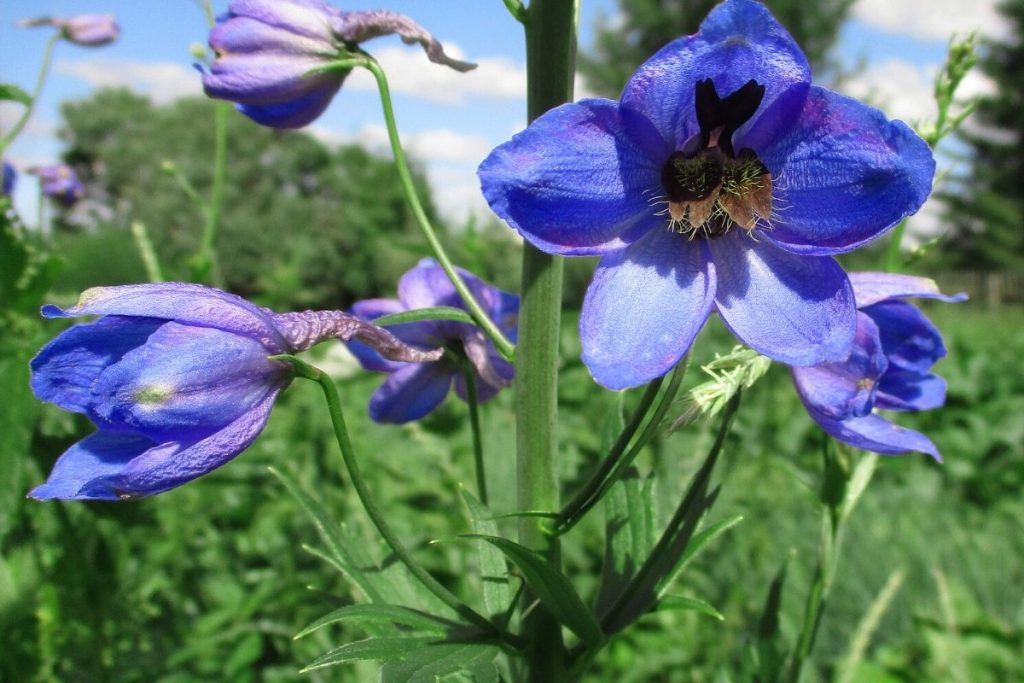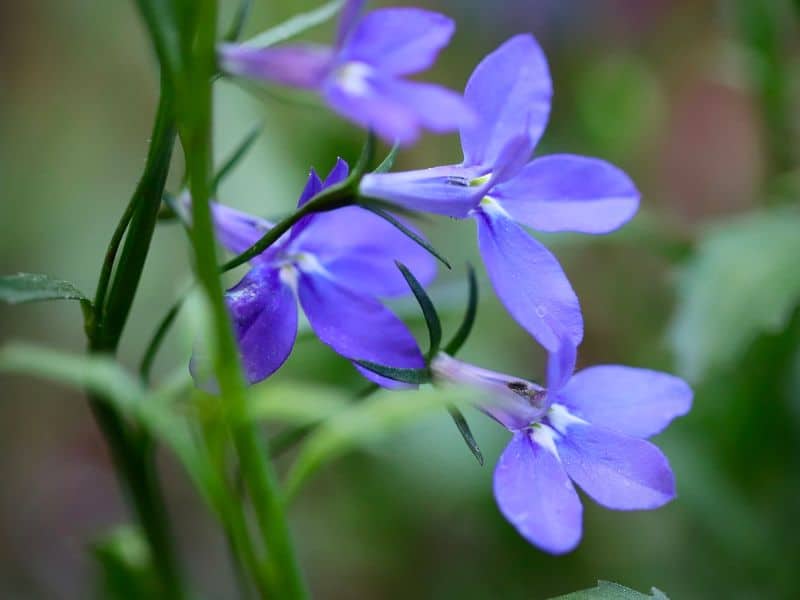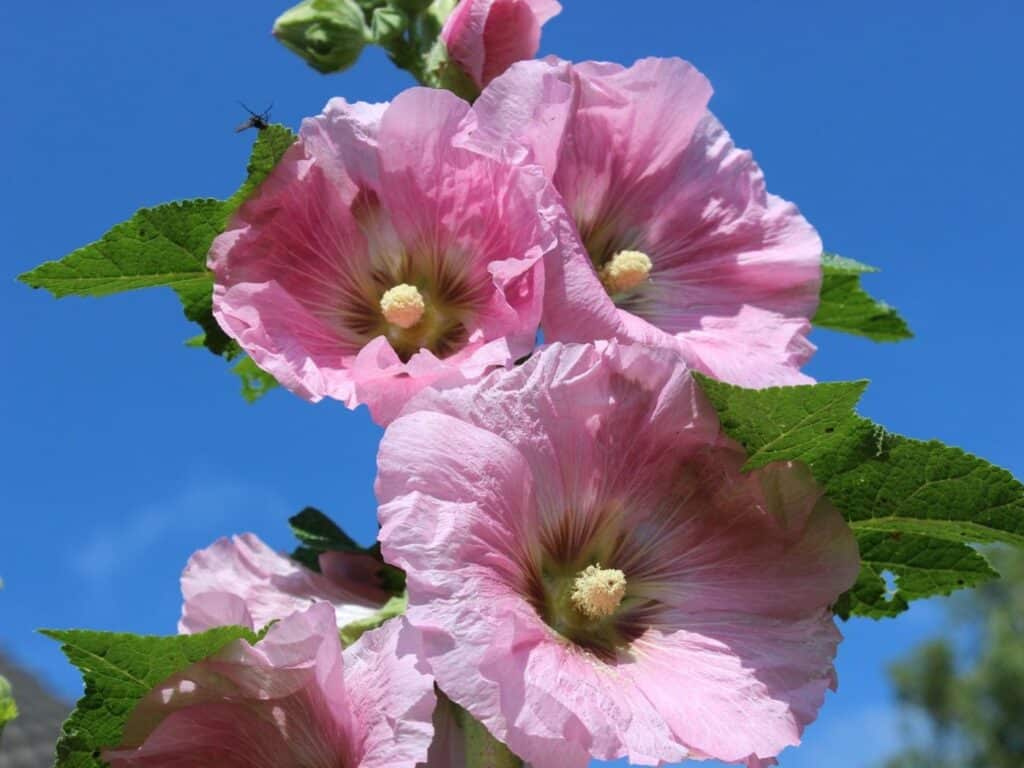Hollyhocks (Alcea rosea) are ideal flowers to add to a cottage garden or cutting garden if you want to add more vertical interest to your spaces. These flowers can grow up to 8 feet tall and produce attractive heart-shaped foliage with stunning flowers that bloom for a very long time.
These impressive flowers come in different hues like white, pink, red, lavender, and yellow, and the tall plants usually produce various showy, rounded flowers on tall spikes that can create an eye-catching effect in your garden.
The tall perennials can be grown with companion plants like foxgloves, delphiniums, peonies, blue mist lobelias, or baby’s breath to create spaces that look even more appealing.
In this guide, we will take a closer look at these companion plants and share some great ways to use and combine them in your garden.
What to Grow with Hollyhocks
Hollyhocks will add lots of vertical interest and color to your garden, but they can look out of place alone. They should be paired with ground covers, garden fillers, and background plants that can even out your landscape and create a fuller effect.
When doing companion planting with hollyhocks, you should also carefully select plant species with similar growing conditions.
These large flowering plants should be placed in a full-sun position. They also prefer organic-rich soils that drain well yet are kept moist for most of the day.
Let’s look at some exciting companion plants for hollyhocks that can also grow well in full sun and moist or humid regions.
Foxgloves

Foxgloves (Digitalis) can help balance the rounded and open shapes of hollyhock flowers because these tall perennials produce vivid bell-shaped blooms on tall stalks. They are also good hollyhock companions because they produce dense foliage at the base of the plant that can conceal the unsightly stems of taller plants in the back.
These flowers come in various colors like red, pink, yellow, white, and purple and are great for attracting lots of pollinators to your garden.
Foxgloves will grow well alongside hollyhocks because they love full sun positions with light, moist soil high in organic matter.
The short-lived perennials should be positioned towards the front of your garden bed because their towering florals will only grow up to 3 feet tall, while hollyhocks can become much taller.
Delphiniums

If you are looking for another majestic towering plant to combine in your flower garden, you should consider delphiniums (Delphinium) or larkspurs. This flower species also produces vivid blooms on tall spikes, but their flowers are smaller with a starry bell shape.
Delphiniums come in many colors, including purple, lavender, pink, scarlet, and white. It is also one of the few flowers that come in a true blue hue, and we do recommend seeking this blue variety out because it will add lots of contrast to your garden space.
These companion plants for hollyhocks need a minimum of 6 hours of direct sun per day and prefer morning sun. They require sheltering from strong winds and rain downpours, or the tall flower towers can flop over. The flowers need fertile, well-drained soil, and they should be watered regularly but shouldn’t be kept too wet or left in standing water.
Delphiniums are almost as tall as hollyhocks and can easily be mixed among them to fill gaps left by the hollyhocks’ growing habits.
Peonies

Hollyhocks can benefit from a ground cover that can keep the soil nice and moist. This is exactly why peonies (Paeonia) are such a great companion plant for hollyhocks. These shrubs form a dense growth and will keep the sun from scorching the soil around the base of your taller plants.
Their shrubby foliage can also fill out gaps and conceal the raggedy appearance of the lower stalks of the hollyhocks.
Peonies come in a huge variety of vibrant colors. They will keep your garden full of life from late spring until early summer, right before the summer flowering perennials kick into action.
This shrubby flower should be grown in the front of your garden because it only grows up to 3 feet tall and must be planted in full sun and well-drained soil.
Blue Mist Lobelia

Blue mist lobelia (Lobelia erinus) is another good ground or base cover for your flower beds. With its delicate foliage and fine blue flowers, this bushy plant is great for filling lower elevations and can brighten up the areas around the base of taller plant species.
This delicate shrub will only grow up to 1 foot tall and is terrific for attracting many butterflies and pollinators to your garden.
The impressive flowers should be positioned in the front of your garden where they will receive lots of direct sunlight. However, they can grow in partial shade and must be planted in well-drained, reliably moist soil.
Baby’s Breath

Baby’s breath (Gypsophila) is a terrific flowering shrub to grow in front of hollyhocks because the tiny flowers and delicate foliage of this bushy plant will add lots of contrast to your garden, and it will conceal any openings amongst the taller plants in the back.
This perennial will bloom from summer until fall, attracting many butterflies to your garden. They are very practical as border plants and come in pink or white flower colors.
Baby’s breath prefers full sun to partial shade position, and they should be grown in well-drained soil. The plant prefers sandy and loam soil types, and they are slightly drought-tolerant but will grow well with frequent watering or in moist conditions.
What NOT to Grow with Hollyhocks
Hollyhocks are thirsty plants and will quickly draw all the moisture from the soil. This can affect plants with delicate root systems that can dry out as a result. It is best not to plant species with sensitive roots like lilacs.
It is also best not to grow hollyhocks with plants that are very sensitive to moisture. Avoid planting hollyhocks with lavender, bee balm, or blanket flowers because these species cannot tolerate moist conditions.
Landscaping Ideas for Hollyhocks and Companions
Hollyhocks are impressive flowers but can be very tall, limiting their functionality. Placing them with lots of sunlight and vertical space would be best. Here is a quick look at the best ways to use hollyhocks and its neighboring plants in your garden.
Showy Mixed Containers
Hollyhocks can grow well in large barrel-shaped containers. The tall flowers will look especially charming if you add lots of filler plants like baby breath or blue mist lobelia all around the base of the plant. This mixture of plants should create impressive containers that are ideal for decorating a sunny patio or can be used to create a focal point in a garden.
Cottage Garden Flower Beds
For a cottage garden effect, it is always good to mix various vigorous blooming plant species of different heights. Place the tall hollyhocks in the back with some tall delphiniums among them. You can then add a second layer of dimension by growing foxgloves in a middle row and create a solid ground cover with some bright flowering peonies or baby’s breath.
Mixed Border Fences
Tall flowers like hollyhocks or delphiniums grow best if a fence or wall at the back supports them. This showy border can then be layered with shorter flowers and ground covers to create an impressive edge alongside your wall or home fence.
Final Thoughts
Hollyhocks are very tall and impressive but look better if you pair them with companion plants like foxgloves, delphiniums, peonies, blue mist lobelias, or baby’s breath. These companions are great for filling out openings or gaps in your garden and will complement the majestic hollyhock blooms.
Creating a stunning garden is easy if you pair a couple of these ornamentals. We hope you enjoyed our guide and will have a lot of fun growing your showy hollyhock garden.
Learn more about Hollyhock symbolism to see why people love this flower!







